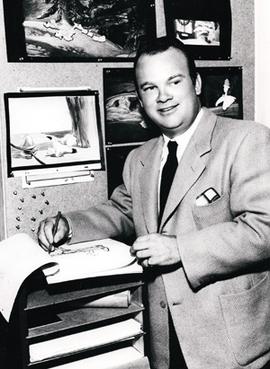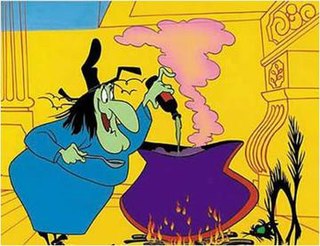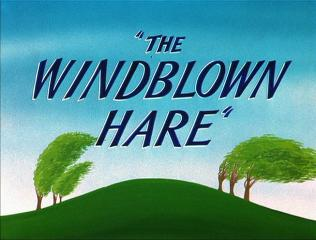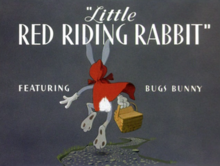
"The Three Little Pigs" is a fable about three pigs who build their houses of different materials. A Big Bad Wolf blows down the first two pigs' houses which are made of straw and sticks respectively, but is unable to destroy the third pig's house that is made of bricks. The printed versions of this fable date back to the 1840s, but the story is thought to be much older. The earliest version takes place in Dartmoor with three pixies and a fox before its best known version appears in English Fairy Tales by Joseph Jacobs in 1890, with Jacobs crediting James Halliwell-Phillipps as the source. In 1886, Halliwell-Phillipps had published his version of the story, in the fifth edition of his Nursery Rhymes of England, and it included, for the first time in print, the now-standard phrases "not by the hair of my chiny chin chin" and "I'll huff, and I'll puff, and I'll blow your house in".

Frederick Bean "Tex" Avery was an American animator, cartoonist, director, and voice actor. He was known for directing and producing animated cartoons during the golden age of American animation. His most significant work was for the Warner Bros. and Metro-Goldwyn-Mayer studios, where he was crucial in the creation and evolution of famous animated characters such as Bugs Bunny, Daffy Duck, Porky Pig, Elmer Fudd, Droopy, Screwy Squirrel, The Wolf, Red Hot Riding Hood, and George and Junior.

Witch Hazel is an animated cartoon character in the Warner Bros. Looney Tunes and Merrie Melodies series of cartoons and TV shows. Witch Hazel is a fairy tale witch antagonist with green skin, a round figure, bulbous facial features, and a single tooth. The name is a pun on the witch-hazel plant and folk remedies based on it.

The Big Bad Wolf is a fictional wolf appearing in several cautionary tales, including some of Grimms' Fairy Tales. Versions of this character have appeared in numerous works, and it has become a generic archetype of a menacing predatory antagonist.

Little Red Riding Hood is a European fairy tale about a young girl and a sly wolf. Its origins can be traced back to several pre-17th-century European folk tales. The two best known versions were written by Charles Perrault and the Brothers Grimm.

Granny is a fictional character created by Friz Freleng, best known from the Looney Tunes and Merrie Melodies animated short films of the 1950s and 1960s. She is the owner of Tweety Bird and, more often than not, Sylvester and Hector. Her voice was first provided by Bea Benaderet from 1950 through 1955, then by June Foray for almost 60 years then Candi Milo took over in 2017 following Foray’s death.
The Looney Tunes Golden Collection is a series of six four-disc DVD sets from Warner Home Video, each containing about 60 Looney Tunes and Merrie Melodies animated shorts originally released from the 1930s to 1960s. The initial run of the series was in folding cardboard packaging issued gradually from October 28, 2003 to October 21, 2008. A boxed set combining all six volumes was released in 2011, and each volume was reissued separately in standard Amaray-style cases in 2020.

Hiawatha's Rabbit Hunt is a 1941 Merrie Melodies cartoon directed by Friz Freleng. Mel Blanc voiced all characters. This film was nominated for the Academy Award for Best Short Subject (cartoons), but lost to Walt Disney's Lend a Paw. This was the first Bugs Bunny cartoon directed by Friz Freleng. The short makes several direct references to The Song of Hiawatha, an epic poem by Henry Wadsworth Longfellow.

Goldilocks and the Jivin' Bears is a 1944 Warner Bros. Merrie Melodies cartoon directed by Friz Freleng and produced by an uncredited Eddie Selzer. The short was released on September 2, 1944.

Bugs Bunny and the Three Bears is a 1944 Merrie Melodies cartoon short directed by Chuck Jones and written by Tedd Pierce. The short was released on February 26, 1944, and features Bugs Bunny. This short marks the first appearance of Jones' dysfunctional version of The Three Bears, and is a parody of the old fairy tale, Goldilocks and The Three Bears.

Three Little Bops is a 1957 American animated musical comedy film, directed by Friz Freleng and written by Warren Foster. A takeoff on The Three Little Pigs told as a hip, jazzy musical, the short features the voice of Stan Freberg, with music provided by jazz composer/trumpeter Shorty Rogers. It was released by Warner Bros. Pictures on January 5, 1957 as part of the Looney Tunes series.

The Little Red Riding Hood fairy tale has often been adapted, and into a wide variety of media.

The Windblown Hare is a Warner Bros. Looney Tunes animated short directed by Robert McKimson. The short was released on August 27, 1949, and stars Bugs Bunny. The title, another pun on "hair", refers to Bugs being subjected to the Wolf's "blowing the houses down".

Looney Tunes Golden Collection: Volume 5 is a Looney Tunes collection on DVD. Following the pattern of one release each year of the previous volumes, it was released on October 30, 2007.

The Big Bad Wolf is an animated short released on April 13, 1934, by United Artists, produced by Walt Disney and directed by Burt Gillett as part of the Silly Symphony series. Acting partly as a sequel to the wildly successful adaptation of The Three Little Pigs of the previous year, this film also acts as an adaptation of the fairy-tale Little Red Riding Hood, with the Big Bad Wolf from 1933's Three Little Pigs acting as the adversary to Little Red Riding Hood and her grandmother.
Red Riding Hoodwinked is a 1955 Warner Bros. Looney Tunes cartoon directed by Friz Freleng. The short was released on October 29, 1955, and stars Tweety and Sylvester.

Now Hare This is a 1958 Warner Bros. Looney Tunes cartoon directed by Robert McKimson and written by Tedd Pierce. The short was released on May 31, 1958, and stars Bugs Bunny.
Little Red Rodent Hood is a 1952 Warner Bros. Merrie Melodies animated short directed by Friz Freleng. The short was released on May 3, 1952, and stars Sylvester in a spoof of "Little Red Riding Hood".

Bugs Bunny's 3rd Movie: 1001 Rabbit Tales is a 1982 animated comedy film by Friz Freleng. It combines classic Warner Bros. cartoon shorts with new animation, with Bugs Bunny serving as the story host.
















